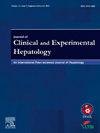Predictors of Mortality in Patients Diagnosed With Autoimmune Hepatitis – Insights from a Prospective, 90-day Follow--up Study
IF 3.3
Q2 GASTROENTEROLOGY & HEPATOLOGY
Journal of Clinical and Experimental Hepatology
Pub Date : 2025-03-13
DOI:10.1016/j.jceh.2025.102546
引用次数: 0
Abstract
Background and aims
The response to corticosteroids and optimal timing for liver transplantation (LT) in patients with autoimmune hepatitis (AIH) remain significant clinical challenges. This study aimed to assess short-term (90-day) mortality in patients with acute AIH (with or without underlying cirrhosis and chronic liver disease) treated with corticosteroids, and to identify factors that predict mortality in this population.
Methods
We conducted a prospective, single-center study between 2022 and 2024, involving patients with histologically confirmed AIH. All patients received corticosteroid treatment and were monitored for various clinical and laboratory parameters on days 3, 7, and 90 after initiating therapy.
Results
A total of 104 patients were included in the study, with a mean age of 46.1 ± 14.3 years; 77% of the patients were female. The 90-day mortality rate following the initiation of corticosteroids was 13.47%. Univariate analysis identified several significant predictors of mortality, including older age, diabetes mellitus, cirrhosis, esophageal varices, hepatic encephalopathy, low serum albumin on day 3, model of end-stage liver disease (MELD) scores on days 3 and 7, and the survival and prognostic factors for acute severe autoimmune hepatitis (SURFASA) score (P < 0.05). Multivariate analysis revealed that MELD score on day 7 (odds ratio [OR] 1.25; 95% confidence interval [CI] {1.09–1.48}; P = 0.00) and SURFASA score (OR 7.46; 95% CI {1.05–53.06}; P = 0.04) were significant. Specifically, a MELD score ≥27.5 on day 7 (area under the receiver operating characteristic curve [AUC] = 0.998) with 100% sensitivity and 97.8% specificity, and a SURFASA score ≥ −2.95 (AUC = 0.969) with 100% sensitivity and 95.6% specificity were highly predictive of mortality.
Conclusion
Despite corticosteroid treatment, mortality rates remain high in the decompensated AIH and acute on chronic liver failure–AIH groups. The SURFASA score, along with MELD scores on days 3 and 7, are strong predictors of mortality and can assist clinicians in making timely decisions regarding referral for early liver transplantation.

自身免疫性肝炎患者死亡率的预测因素——来自一项前瞻性、90天随访研究的见解
背景与目的自身免疫性肝炎(AIH)患者对皮质类固醇的反应和肝移植(LT)的最佳时机仍然是重大的临床挑战。本研究旨在评估接受皮质类固醇治疗的急性AIH(伴有或不伴有潜在肝硬化和慢性肝病)患者的短期(90天)死亡率,并确定预测该人群死亡率的因素。方法:我们在2022年至2024年间进行了一项前瞻性、单中心研究,纳入了组织学证实的AIH患者。所有患者均接受皮质类固醇治疗,并在开始治疗后第3、7和90天监测各种临床和实验室参数。结果共纳入104例患者,平均年龄46.1±14.3岁;77%的患者为女性。开始使用皮质类固醇后90天死亡率为13.47%。单因素分析确定了几个重要的死亡率预测因素,包括年龄、糖尿病、肝硬化、食管静脉曲张、肝性脑病、第3天的低血清白蛋白、第3天和第7天的终末期肝病模型(MELD)评分,以及急性严重自身免疫性肝炎(SURFASA)评分的生存和预后因素(P <;0.05)。多因素分析显示,MELD评分在第7天(优势比[OR] 1.25;95%置信区间[CI] {1.09-1.48};P = 0.00)和SURFASA评分(OR 7.46;95% ci {1.05-53.06};P = 0.04)。其中,第7天MELD评分≥27.5(受试者工作特征曲线下面积[AUC] = 0.998),灵敏度为100%,特异性为97.8%;SURFASA评分≥- 2.95 (AUC = 0.969),灵敏度为100%,特异性为95.6%,对死亡率具有较高的预测价值。结论尽管接受皮质类固醇治疗,失代偿性AIH和急性和慢性肝衰竭- AIH组的死亡率仍然很高。SURFASA评分以及第3天和第7天的MELD评分是死亡率的有力预测指标,可以帮助临床医生及时决定是否进行早期肝移植转诊。
本文章由计算机程序翻译,如有差异,请以英文原文为准。
求助全文
约1分钟内获得全文
求助全文
来源期刊

Journal of Clinical and Experimental Hepatology
GASTROENTEROLOGY & HEPATOLOGY-
CiteScore
4.90
自引率
16.70%
发文量
537
审稿时长
64 days
 求助内容:
求助内容: 应助结果提醒方式:
应助结果提醒方式:


